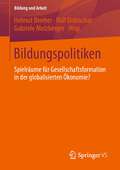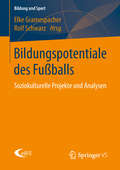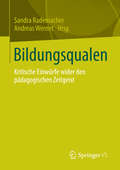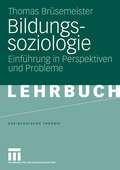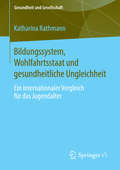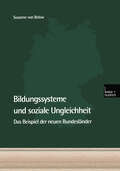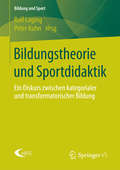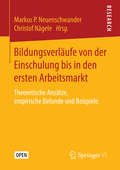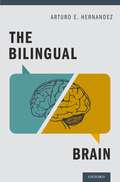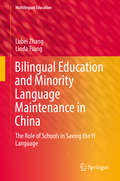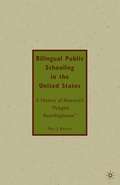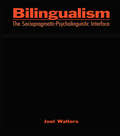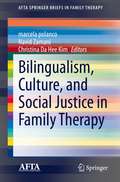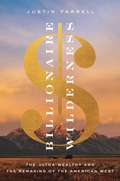- Table View
- List View
Bildungspolitiken: Spielräume für Gesellschaftsformation in der globalisierten Ökonomie? (Bildung und Arbeit #7)
Der Band beleuchtet Reichweiten und Grenzen von Bildungspolitiken. Leitend ist die These, dass unter dem Diktat grenzüberschreitender Kapitalverwertung der Druck auf die Bildungssysteme, sich deren Interessen anzupassen, zwar zunimmt, dass aber dennoch Spielräume – alternative Entwicklungspfade – jenseits neoliberaler Glaubenssätze und Durchsetzungsstrategien nicht nur denkbar, sondern auch gegeben sind.
Bildungspotentiale des Fußballs: Soziokulturelle Projekte und Analysen (Bildung und Sport #12)
by Elke Gramespacher Rolf SchwarzDer Fußball bietet neben Chancen zur sozialen Integration auch enormes Potential zur sprachlichen, sport- und interkulturellen Bildung. Der vorliegende Band präsentiert im ersten Teil fünf sozialkulturell motivierte Fußballprojekte aus Deutschland und der Schweiz. Diese Projekte werden im zweiten Teil miteinander in einen Zusammenhang gebracht und deren Potentiale eingehend analysiert. Der Band gibt Anregungen für Konzepte sowie vielfältige Orientierungs- und Anknüpfungspunkte für neue sozialkulturell motivierte Fußballprojekte, die sich den Bildungspotentialen dieser Sportart widmen möchten. Der Inhalt • Das Potential sozialkulturell motivierter Fußballprojekte • Fünf sozialkulturell motivierte Fußballprojekte in den Settings Schule, Kooperation Schule/Verein und Soziale Arbeit • Projektmanagement, Projektevaluation und didaktische Analyse von sozialkulturell motivierten Fußballprojekten Die Zielgruppen • Fachcommunity Sport- und Bildungswissenschaften • Sportlehrer und -lehrerinnen an (Ganztags-)Schulen mit erhöhtem Integrationsbedarf • Fachkräfte der Sozialen Arbeit sowie der Kinder- und Jugendhilfe • Vereinstrainer und -trainerinnen sowie Funktionäre und Funktionärinnen Die Herausgeber Dr. Elke Gramespacher ist Professorin für Bewegungsförderung und Sportdidaktik am Institut Kindergarten-/Unterstufe an der Pädagogischen Hochschule FHNW, Windisch, Schweiz. Dr. Rolf Schwarz ist Professor am Institut für Bewegungserziehung und Sport der Pädagogischen Hochschule Karlsruhe.
Bildungspotenziale von Literatur im Pflegeunterricht: Eine Untersuchung am Beispiel Sterben (BestMasters)
by Verena MüllerVerena Müller unternimmt den Versuch, eine Schnittstelle zwischen fiktionaler Literatur und der Pflegeausbildung herzustellen. Hierfür untersucht sie mit Blick in verschiedene Bezugswissenschaften, ob und wie der Einsatz von literarischen Texten den Weg zu einem ästhetischen Lernen im Pflegeunterricht bereitet. Dabei fokussiert sie exemplarisch den pflegerisch relevanten Zusammenhang von Tod und Sterben, um die Ausführungen zu rahmen. Dazu führt sie Erkenntnisse der Literaturdidaktik, der allgemeinen Erziehungswissenschaften und der Medical Humanities hinsichtlich des Einsatzes von literarischen Texten zusammen, setzt diese in Bezug zu den Zielen der Pflegedidaktik und leitet relevante Aspekte ab. Anknüpfend an die Ergebnisse zeigt sie in einer pflegedidaktischen Analyse zweier literarischer Texte beispielhaft pflegedidaktische Gewinne auf.
Bildungsqualen: Kritische Einwürfe wider den pädagogischen Zeitgeist
by Sandra Rademacher Andreas WernetDie Bildungswirklichkeit bleibt weit hinter den an sie gerichteten Erwartungen zurück. Das weiß auch die „Bildungswissenschaft“. Aber statt diesen Problemkomplex freizulegen, befeuert sie ihn. Sie hat sich in einer Arbeitsteilung zwischen technokratischen Steuerungsfantasien und emphatischen Bildungssemantiken behaglich eingerichtet hat. Der Band will sich dem widersetzen. Die Einwürfe eröffnen in empirischer und theoretischer Hinsicht Perspektiven jenseits des Mainstreams. Zu Ehren Elisabeth Flitners haben Sandra Rademacher und Andreas Wernet namhafte Wissenschaftlerinnen und Wissenschaftler mit Beiträgen in einem ebenso provozierenden wie weiterführenden Band zusammengebracht.
Bildungssoziologie: Einführung in Perspektiven und Probleme (Soziologische Theorie)
by Thomas BrüsemeisterDas Buch gibt einen Überblick über verschiedene Ansätze der Bildungssoziologie. Nach PISA ist das Interesse an bildungssoziologischen Erklärungen von Ungleichheitsdimensionen gestiegen. Die Perspektiven der Bildungssoziologie wurden jedoch schon weitaus früher entfaltet; teilweise können die in den 1970er Jahren entwickelten Modelle immer noch Relevanz beanspruchen. Zudem sind neuere Ansätze hinzugekommen. Wie im Buch gezeigt wird, stehen heute institutionen- und sozialisationstheoretische, ungleichheits- und differenzierungstheoretische, entscheidungstheoretische, phänomenologische und organisationsbezogene Konzepte als Perspektiven der Bildungssoziologie zur Verfügung, die auch von anderen Disziplinen genutzt werden können.
Bildungssoziologie: Eine Einführung anhand empirischer Studien
by Johannes KoppBildung ist eines der wichtigsten Themen im Bereich der sozialen Ungleichheit, und spätestens seit den Ergebnissen der PISA-Studie finden die verschiedenen wissenschaftlichen Diskussionen auch in der Öffentlichkeit wieder Resonanz. Ziel dieser Einführung ist es nun, einen Überblick über die verschiedenen Diskussionslinien der Bildungssoziologie und deren Ergebnisse zu geben. Dabei beginnt dieser Überblick bei der historischen Bildungsforschung, die die Wurzeln einiger auch noch heute das Bildungssystem bestimmender Charakteristika wie etwa dessen Dreigliedrigkeit aufzeigt, konzentriert sich danach aber auch auf die Frage der schichtspezifischen Bildungsungleichheit. Hierbei sollen sowohl die älteren, als auch neuere empirische Studien zu dieser Fragestellung und ihre jeweilige theoretische Fundierung vorgestellt werden. Den Abschluss dieser Darstellung bildet die Frage nach der ethnischen Dimension sozialer Ungleichheit. In dieser Einführung werden die wichtigsten theoretischen Diskussionslinien, vor allem aber die jeweiligen empirischen Studien und ihre Ergebnisse in einer übersichtlichen und verständlichen Art vorgestellt.
Bildungssoziologie: Theorien - Institutionen - Debatten
by Antonia KupferDieses Buch ist ein Beitrag zur Bildungssoziologie und gewährt den Lesenden sowohl Grundlagenwissen als auch Einblick in aktuelle Debatten und Analysen. Es werden wichtige Klassiker der Bildungssoziologie aus dem deutsch-, englisch- und französischsprachigen Raum verständlich erläutert. In systematischer Weise wird in das Bildungssystem mit Hilfe soziologischer Analysen der Schule, der beruflichen Bildung, der Hochschule und der Erwachsenen- und Weiterbildung umfassend eingeführt. Anhand thematischer Felder werden die zentralen aktuellen Debatten um Bildung und soziale Ungleichheit, um Bildung und Erwerbstätigkeit und die Wissensgesellschaft vorgestellt.
Bildungsstaat: Aufstieg • Herausforderungen • Perspektiven (Stichworte: Wissen kompakt #0)
by Ansgar WeymannDer souveräne Bildungsstaat garantiert Bildung als Bürgerrecht und als attraktive persönliche Lebenschance. Er nutzt Bildung zur Förderung von Wirtschaftswachstum und Wohlstand in einer Welt mit internationalem Wettbewerb auf immer mehr Gebieten und als Mittel sozialer und kultureller Integration der Bevölkerung. Der Bildungsstaat wurde zum Stolz der Nationen und zum beliebten Instrument des Wohlfahrtsstaates mit ausgreifenden sozialpolitischen Inanspruchnahmen, eine moderne Zivilreligion mit scheinbar unerschöpflichen Heilsversprechen. Doch die Grenzen des Wachstums sind sichtbar: Bildungserträge stagnieren, soziale Ungleichheit bleibt dauerhaft, das internationale Medieninteresse an Bildung schrumpft. Hat der Bildungsstaat seinen Gipfel erreicht? Oder durchläuft er einen Innovationszyklus im Zuge nichtwestlicher Globalisierung?
Bildungssystem, Wohlfahrtsstaat und gesundheitliche Ungleichheit: Ein internationaler Vergleich für das Jugendalter (Gesundheit und Gesellschaft)
by Katharina RathmannKatharina Rathmann untersucht erstmals die Bedeutung struktureller Merkmale von Bildungssystemen (Differenzierung, Segregation, öffentlicher vs. privater Sektor) sowie Wohlfahrtsstaaten für das Ausmaß der sozialen Ungleichheit in der Gesundheit von Jugendlichen. Denn neben individuellen Determinanten der Gesundheit und sozial bedingten Ungleichheit werden in ländervergleichenden Studien zunehmend auch makro-strukturelle Determinanten der Gesundheit und gesundheitlichen Ungleichheit berücksichtigt. Basierend auf Daten der WHO-Studie „Health Behaviour in School-aged Children“ (HBSC) stellt die Autorin repräsentative empirische Befunde für die Gesundheit und gesundheitliche Ungleichheit von Jugendlichen in 34 europäischen und nordamerikanischen Ländern vor.
Bildungssysteme und soziale Ungleichheit: Das Beispiel der neuen Bundesländer
by Susanne von BelowWie unterscheiden sich die Bildungssysteme in den Bundesländern und wie wirken sich die verschiedenen Typen auf Bildungsbeteiligung und soziale Ungleichheit aus? Dieses Buch stellt eine Typologie der Bildungssysteme vor und zeigt die enormen Konsequenzen der verschiedenen Typen für die Chancenverteilung von Jugendlichen am Beispiel der neuen Bundesländer.
Bildungstheorie und Sportdidaktik: Ein Diskurs zwischen kategorialer und transformatorischer Bildung (Bildung und Sport #9)
by Ralf Laging Peter KuhnDas Buch greift Diskurse zur fachlichen Bildung und Didaktik auf, die das Bewegungshandeln als Modus der Weltbegegnung verstehen. Thematisiert werden relationale Bildungskonzepte, die die Mensch-Welt-Begegnung in den Mittelpunkt rücken. Damit wird auf Ansätze verwiesen, die sich zwischen kategorialen und transformatorischen Bildungsvorstellungen verorten lassen.Die HerausgeberDr. Ralf Laging ist Professor für Bewegungs- und Sportpädagogik am Fachbereich Erziehungswissenschaften der Philipps-Universität Marburg.Dr. Peter Kuhn ist Professor für Sportpädagogik und -didaktik am Institut für Sportwissenschaft der Universität Bayreuth.
Bildungsverläufe von der Einschulung bis in den ersten Arbeitsmarkt: Theoretische Ansätze, empirische Befunde und Beispiele
by Markus P. Neuenschwander Christof NägeleExpertinnen und Experten zeigen in Originalbeiträgen, wie an verschiedenen Stellen von der Grundschule bis zur Wahl einer weiteren Ausbildung nach der Grundausbildung Bildungsverläufe beeinflusst werden, beispielsweise durch die Förderung von verhaltensauffälligen Kindern in der Grundstufe, durch die Gestaltung von Selektionsverfahren in die Sekundarstufe I oder durch die Organisation der Berufsorientierung vor der Sekundarstufe II. Der Sammelband vereint neue theoretische Ansätze und empirische Befunde, die auf aktuellen, längsschnittlichen Datensätzen beruhen.
Bildungsverlierer: Neue Ungleichheiten
by Gudrun Quenzel Klaus HurrelmannObwohl Bildungsbenachteiligung seit langem ein Thema der Ungleichheitsforschung ist, sind die individuellen und strukturellen Ursachen der neuen Bildungsarmut nur wenig erforscht. Das Buch schließt diese Lücke. Während sich der Wettbewerb auf dem Arbeitsmarkt verschärft, geraten diejenigen ins Hintertreffen, die den wachsenden Qualifikationsanforderungen nicht nachkommen. Diese sind von dauerhafter Exklusion aus dem Arbeitsmarkt bedroht - mit Konsequenzen für die soziale Integration, die Lebenszufriedenheit, die Gesundheit und die politischen Einstellungen. Dieses Buch versammelt die aktuelle Forschung über die Ursachen und die Folgen der neuen Ungleichheiten in der Bildungsgesellschaft. Es beantwortet die Frage, wer heute zu den „Bildungsverlieren“ gehört, welche individuellen und gesellschaftlichen Ursachen Bildungsarmut hat, was es für ein Individuen bedeutet, zu den „Bildungsverlierern“ zu gehören, was es eine Gesellschaft kostet, einen Teil ihrer Jugend quasi „abzuhängen“, und sucht nach effizienten politischen und pädagogischen Interventionsansätzen.
Bilingual Creativity and Arab Contact Literature: Towards a World Englishes and Translation Studies Framework
by Dina HassanThis book adopts an integrated approach to the study of contact literature through collaboration between theories of World Englishes and translation studies. The author proposes an interactive framework that integrates linguistic and cultural perspectives, through the analysis of selected Anglo-Arab and Arab-American contact literary texts: Samia Serageldine’s The Cairo House (2000), Leila Ahmed’s A Border Passage (1999), Leila Aboulela’s The Translator (1999), Ahdaf Soueif’s The Map of Love (2000), and Abdelkebir Khatibi’s Love in Two Languages (1990). The author then discusses the pedagogical implications of bilingual creativity via a language in literature approach. This book will be of interest to students and scholars of translation studies, literature and cultural studies.
Bilingual Education and Minority Language Maintenance in China: The Role of Schools in Saving the Yi Language (Multilingual Education #31)
by Lubei Zhang Linda TsungThis book looks closely at Yi bilingual education practice in the southwest of China from an educationalist’s perspective and, in doing so, provides an insight toward our understanding of minority language maintenance and bilingual education implementation in China. The book provides an overview on the Yi people since 1949, their history, society, culture, customs and languages. Adopting the theory of language ecology, data was collected among different Yi groups and case studies were focused on Yi bilingual schools. By looking into the application of the Chinese government’s multilingual language and education policy over the last 30 years with its underlying language ideology and practices the book reveals the de facto language policy by analyzing the language management at school level, the linguistic landscape around the Yi community, as well as the language attitude and cultural identities held by present Yi students, teachers and parents. The book is relevant for anyone looking to more deeply understand bilingual education and language maintenance in today’s global context.
Bilingual Public Schooling in the United States: A History of America's "Polyglot Boardinghouse"
by P. RamseyThis history of one of the most contentious educational issues in America examines bilingual instruction in the United States from the common school era to the recent federal involvement in the 1960s and 1970s. Drawing from school reports, student narratives, legal resources, policy documents, and other primary sources, the work teases out the underlying agendas and patterns in bilingual schooling during much of America s history. The study demonstrates clearly how the broader context - the cultural, intellectual, religious, demographic, economic, and political forces - shaped the contours of dual-language instruction in America between the 1840s and 1960s. Ramsey s work fills a crucial void in the educational literature and addresses not only historians, linguists, and bilingual scholars, but also policymakers and practitioners in the field.
Bilingualism (Routledge Guides to Linguistics)
by Shahrzad MahootianBilingualism provides a concise and lively introduction to bilingualism as a social and linguistic phenomenon and explains its impact on individuals and on society. Addressing questions such as what it means to be bilingual, how one becomes bilingual, and how exposure to more than one language can hinder or enhance a child’s cognitive development, this book features: an introduction to the linguistic, sociolinguistic, and cognitive outcomes of bilingualism, including bilingual language acquisition, the grammar of language-mixing, the link between language choice and identity, and the value of maintaining and promoting bilingualism; up-to-date overviews of the prominent concerns and facts about bilingualism; activities and discussion questions which invite readers to consider their own perspectives on bilingualism and how it manifests in their own lives and communities; links to relevant videos and suggested further reading, including topical novels, short stories, and essays. Aimed at students with no background in linguistics, this book is essential reading for anyone studying bilingualism for the first time.
Bilingualism (Routledge Guides to Linguistics)
by Shahrzad MahootianBilingualism provides a concise and lively introduction to bilingualism as a social and linguistic phenomenon and explains its impact on individuals and on society. Addressing questions such as what it means to be bilingual, how one becomes bilingual, and how exposure to more than one language can hinder or enhance a child’s cognitive development, this book features: an introduction to the linguistic, sociolinguistic, and cognitive outcomes of bilingualism, including bilingual language acquisition, the grammar of language-mixing, the link between language choice and identity, and the value of maintaining and promoting bilingualism; up-to-date overviews of the prominent concerns and facts about bilingualism; activities and discussion questions which invite readers to consider their own perspectives on bilingualism and how it manifests in their own lives and communities; links to relevant videos and suggested further reading, including topical novels, short stories, and essays. Aimed at students with no background in linguistics, this book is essential reading for anyone studying bilingualism for the first time.
Bilingualism: The Sociopragmatic-Psycholinguistic Interface
by Joel WaltersIn the past 30 years, the study of bilingualism processing has been conducted independently by two fields, psycholinguistics and sociolinguistics. This volume merges these two fields, addressing one of the tough problems dividing researchers in bilingualism, conceptually as well as methodologically. Joel Walters proposes a new approach to bilingualism processing--the Sociopragmatic-Psycholinguistic (SPPL) Model--which presents language as a social phenomenon. The author accomplishes this by identifying and organizing evidence from a wide range of linguistic disciplines, merging sociopragmatics, discourse analysis, and ethnography with social cognition, psycholinguistics, and neuroscience. By extension, the author offers convincing explanations of how related fields can profit from a comprehensive bilingual processing model. As a result, Joel Walters delivers a well-organized, comprehensive model that is thought through at every level. This book appeals to graduate students, scholars in the fields of linguistics, bilingualism, second language acquisition, psycholinguistics, and sociolinguistics. It is useful to researchers for its comprehensiveness and methodological acumen and may be appropriate as a supplementary textbook for graduate-level courses in bilingualism or for seminars on similar topics.
Bilingualism: The Sociopragmatic-Psycholinguistic Interface
by Joel WaltersIn the past 30 years, the study of bilingualism processing has been conducted independently by two fields, psycholinguistics and sociolinguistics. This volume merges these two fields, addressing one of the tough problems dividing researchers in bilingualism, conceptually as well as methodologically. Joel Walters proposes a new approach to bilingualism processing--the Sociopragmatic-Psycholinguistic (SPPL) Model--which presents language as a social phenomenon. The author accomplishes this by identifying and organizing evidence from a wide range of linguistic disciplines, merging sociopragmatics, discourse analysis, and ethnography with social cognition, psycholinguistics, and neuroscience. By extension, the author offers convincing explanations of how related fields can profit from a comprehensive bilingual processing model. As a result, Joel Walters delivers a well-organized, comprehensive model that is thought through at every level. This book appeals to graduate students, scholars in the fields of linguistics, bilingualism, second language acquisition, psycholinguistics, and sociolinguistics. It is useful to researchers for its comprehensiveness and methodological acumen and may be appropriate as a supplementary textbook for graduate-level courses in bilingualism or for seminars on similar topics.
Bilingualism, Culture, and Social Justice in Family Therapy (AFTA SpringerBriefs in Family Therapy)
by Marcela Polanco Navid Zamani Christina Da Hee KimThis volume advocates for justice in language rights through its explorations of bilingualism in family therapy, from the perspectives of eighteen languages identified by the authors: Black Talk/Ebonics/Slang, Farsi, Fenglish, Arabic, Italian, Cantonese Chinese, South Korean, Mandarin Chinese, Vietnamese, Spanish, Chilean Spanish, Mexican Spanish, Colombian Spanglish, Madrileño Spanish, Spanglish, Pocho Spanish, Colloquial Spanish, and English. It identifies standard English as the current language most often used across family therapy programs and services in the United States. The book discusses efforts to respond to the rapidly changing linguistic landscape and the increasingly high demand for appropriate therapy services that respond effectively to diverse families in America. It discusses recruitment and training of linguistically diverse family therapists and strategies to promote linguistic equality to support the rights of family therapists, their practices, and the communities they serve. Chapters explore ways to integrate languages in professional and personal lives, including the improvisational, self-taught translanguaging skills and practices that go beyond the lexical and grammatical rules of a language. The book describes the creative use of native or heritage languages to ensure that the juxtaposition of English therapeutic and daily-life landscapes is integrated into family therapy settings. It discusses contextual, relational, therapeutic, and training potential offered by bilingualism as well as the necessary transmutations in theory and practice. This volume is an essential resource for clinicians, therapists, and practitioners as well as researchers, professors, and graduate students in family studies, clinical psychology, and public health as well as all interrelated disciplines.
Bilingualism: A Social Approach (Palgrave Advances in Language and Linguistics)
by M. HellerArguing against a common sense view of bilingualism as the co-existence of two linguistic systems, this volume develops a critical perspective which approaches bilingualism as a wide variety of sets of sociolinguistic practices connected to the construction of social difference and of social inequality under specific historical conditions.
Billionaire Wilderness: The Ultra-Wealthy and the Remaking of the American West (Princeton Studies In Cultural Sociology Ser. #83)
by Justin FarrellA revealing look at the intersection of wealth, philanthropy, and conservationBillionaire Wilderness takes you inside the exclusive world of the ultra-wealthy, showing how today's richest people are using the natural environment to solve the existential dilemmas they face. Justin Farrell spent five years in Teton County, Wyoming, the richest county in the United States, and a community where income inequality is the worst in the nation. He conducted hundreds of in-depth interviews, gaining unprecedented access to tech CEOs, Wall Street financiers, oil magnates, and other prominent figures in business and politics. He also talked with the rural poor who live among the ultra-wealthy and often work for them. The result is a penetrating account of the far-reaching consequences of the massive accrual of wealth, and an eye-opening and sometimes troubling portrait of a changing American West where romanticizing rural poverty and conserving nature can be lucrative—socially as well as financially.Weaving unforgettable storytelling with thought-provoking analysis, Billionaire Wilderness reveals how the ultra-wealthy are buying up the land and leveraging one of the most pristine ecosystems in the world to climb even higher on the socioeconomic ladder. The affluent of Teton County are people burdened by stigmas, guilt, and status anxiety—and they appropriate nature and rural people to create more virtuous and deserving versions of themselves. Incisive and compelling, Billionaire Wilderness reveals the hidden connections between wealth concentration and the environment, two of the most pressing and contentious issues of our time.
BIM-enabled Cognitive Computing for Smart Built Environment: Potential, Requirements, and Implementation
by Ibrahim YitmenThe book provides knowledge in the Building Information Model (BIM)-enabled cognitive computing methods for smart built environment involving cognitive network capabilities for smart buildings, integrating Augmented Reality/Mixed Reality in cognitive building concepts, cognitive Internet of Things (CIoT) for smart cities, Artificial Intelligence applications for cognitive cities, and cognitive smart cities using big data and machine learning. It focuses on the potential, requirements and implementation of CIoT paradigm to buildings, Artificial Intelligence techniques, reasoning, and Augmented Reality/Mixed Reality in cognitive building concepts, the concept of cognitive smart cities in its complexity, heterogeneity, and scope, and the challenge of utilizing the big data generated by smart cities from a machine learning perspective. The book comprises BIM-based and data-analytic research on cognitive IoT for smart buildings and cognitive cities using big data and machine learning as complex and dynamic systems. It presents applied theoretical contributions fostering a better understanding of such systems and the synergistic relationships between the motivating physical and informational settings. It reviews ongoing development of BIM-based and data science technologies for the processing, analysis, management, modeling, and simulation of big and context data and the associated applicability to cognitive systems that will advance different aspects of future cognitive cities. The book also analyses the required material to inform pertinent research communities of the state-of-the-art research and the latest development in the area of cognitive smart cities development, as well as a valuable reference for planners, designers, strategists, and ICT experts who are working towards the development and implementation of CIoT based on big data analytics and context–aware computing.
